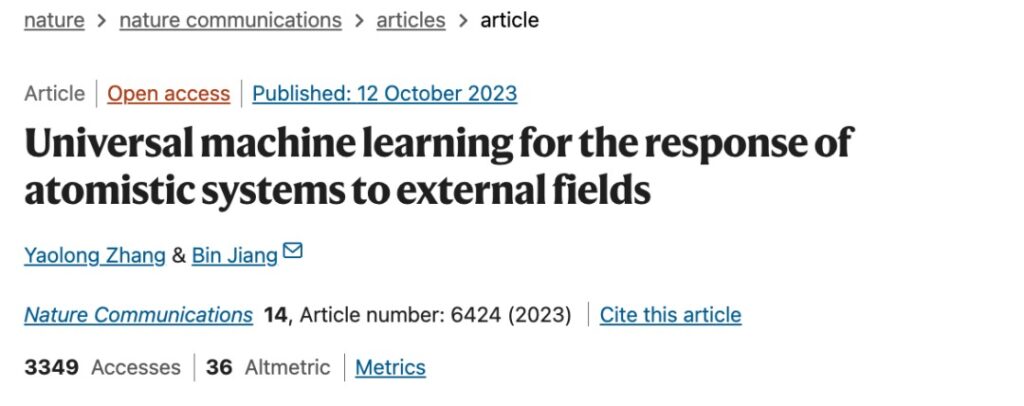Jiang Bin's Research Group at USTC Developed FIREANN to Analyze the Response of Atoms to External Fields

Contents at a glance:The traditional method of analyzing the interaction between chemical systems and external fields has disadvantages such as low efficiency and high cost. Jiang Bin's research group at the University of Science and Technology of China introduced field-related features in the description of atomic environments and developed FIREANN, which used machine learning to describe the field correlation of the system well.
Keywords:Chemical physics Molecular dynamics External fields
Author | Xuecai
Editor | Li Baozhu
The interaction between chemical systems and external fields is crucial in physical, chemical and biological processesExternal fields, mainly electric fields, can interact with atoms, molecules and condensed matter, leading to electron or spin polarization, or changing the spatial orientation of the system.
Density functional theory (DFT) and ab initio molecular dynamics (AIMD) have been used to study complex periodic and non-periodic systems under applied electric fields.AIMD applications are demanding, which is particularly difficult to use in systems where nuclear quantum effects (NQEs) are important.
Empirical force field analysis is highly efficient but has limited accuracy, while accurate field-dependent quantum scattering calculations are only applicable to very small systems..
at the same time,Machine learning (ML) has achieved remarkable results in solving high-dimensional chemistry problemsHowever, most machine learning models separate the potential energy and the system's response to the electric field, ignoring the field correlation of the system.
to this end,Jiang Bin's group at the University of Science and Technology of China introduced field-related features in the description of atomic environments and developed the Field-Induced Recursive Embedding Atomic Neural Network (FIREANN)FIREANN can not only accurately describe the changing trend of system energy when the external field strength and direction change, but also predict the system response of any order. This result has been published in "Nature Communication".

This result has been published in Nature Communications.
Paper link:
https://www.nature.com/articles/s41467-023-42148-y
FIREANN model link:
https://github.com/zhangylch/FIREANN
Follow the official account and reply "interaction" to get the full PDF of the paper
FIREANN:REANN + pseudo-atomic field vector
The basis of FIREANN is the REANN model, which describes the atomic environment via embedded atomic densities (EADs).When an external field is applied, the electron density will be redistributed and the rotational invariance of the system will be destroyed.The interaction between the system and the external field is obviously affected by the strength and direction of the electric field.

FIREANN's Architecture
FIREANN assigns a pseudo-atomic field vector to each atom that simulates the behavior of a real atom., and then the two are combined to obtain the field-dependent embedded atomic density, which is used as the input of the neural network, and finally outputs physical quantities such as atomic force, dipole moment, and polarizability.
The pseudo-atomic field vector of each atom can be expressed as:

Then,Combining field-dependent orbitals and Gaussian orbitals (GTOs) into field-induced EADs (FI-EAD) vectors:

Here, the external field to each atom is represented by the position vector of the pseudo-atom relative to that atom. FI-EAD can then be rewritten in terms of the interatomic distances and the enclosed angle:

Experimental verification
Toy Model: Accurate prediction and extrapolation of water molecules
The researchers first used water molecules as a toy system to verify FIREANN's predictions about the system-external field interaction.There is a water molecule on the yz plane and an electric field with a strength of 0.1 V/Å in the x direction.
Since the external field and the molecular plane are always orthogonal, the potential energy of the molecule does not change. FIREANN accurately predicted this result.
at the same time,FIREANN accurately predicts the dipole-electric field interaction when a molecule rotates along the y-axis.

FIREANN prediction of the influence of external electric field on water molecules on the yz surface
a: The case where water molecules rotate along the x-axis;
b: The rotation of water molecules along the y axis;
c: Prediction results of DFT, FIREANN and FieldSchNet when the electric field strength varies.
FIREANN also has strong extrapolation capabilities, using only a single training data, it was able to infer the change in molecular potential energy when the electric field strength was -0.2-0.2 V/Å. This is something that the traditional FieldSchNet model cannot do.
NMA:Accurate prediction of IR spectra
A typical feature of FIREANN is thatIt can predict in one step the energy and response characteristics of chemical systems in the presence and absence of external fields..
The researchers tested it on N-methylacetamide (NMA). When the external electric field varied from 0.0 to 0.4 V/Å, FIREANN was able to effectively predict the energy, dipole moment, and polarizability of the NMA molecule.The root mean square errors (RMSEs) are 0.0053 eV, 0.028 Debye, and 0.51 au, respectively. .

Correlation plot of FIREANN and DFT predictions of NMA energy (a), dipole moment (b), and polarizability (c)
FIREANN also predicted the molecular spectra in the field. When the electric field strength gradually increased from 0.0 to 0.4 V/Å in steps of 0.1 V/Å, the change in the CO stretching band was most obvious. As the electric field strength increased, the P/R branch of the CO stretching band gradually disappeared, and the absorption peak became sharper.
In addition, FIREANN predicted that an applied electric field would reduce the strength of chemical bonds, causing the stretching vibration of CO to redshift, with the distance proportional to the electric field strength.

FIREANN prediction results of NMA at 300 K under different electric fields
liquid: Highly consistent with the periodic system
To verify the ability of the FIREANN model to predict the response of a periodic system to an applied electric field, the researchers conducted tests in liquid water.Unlike molecular systems, the polarization intensity (dipole moment per unit volume) of periodic systems is a multi-valued quantity, which leads to the existence of multiple parallel branches and causes sudden changes in the dipole moment.
In the AIMD prediction, we can clearly see the discontinuity of the results caused by the mutation of the dipole moment. After the external electric field is applied, this mutation will become more frequent, which poses a challenge to traditional machine learning algorithms.

AIMD, modified AIMD and FIREANN analysis of the dipole moment of liquid water without field (a) and with field (b)
In the FIREANN framework, since the model only trains atomic forces in the presence of an electric field, the energy gradient of the system is actually unaffected, so this problem is easily circumvented.
To this end, the researchers constructed a model containing 64 water molecules, an electric field strength of 0.6 V/Å in the x-direction, and atomic force as the only prediction object, called FIREANN-wF.The model's predictions of atomic forces are highly consistent with experiments, with a root mean square error of only 39.4 meV/Å.
The predictions of FIREANN-wF for the field-free radial distribution functions (RDFs) of liquid water are also consistent with DFT and experimental results.

FIREANN predictions of radial distribution functions of OO (a), OH (b), and HH (c), and comparison with experimental results
The dipole moment has an important influence on the IR spectrum. Since the FIREANN-wF model analyzes the nuclear quantum effect,It can correctly predict the potential energy surface (PES) and dipole moment surface, which is consistent with the results of DFT.
Subsequently, FIREANN-wF was used to predict the IR spectrum after applying 0.4 V/Å. Since the electric field reduces the strength of the OH bond and induces the water molecules to be parallel to the electric field, the OH stretching band in the spectrum shows an obvious red shift.

FIREANN's prediction of the spectrum of liquid water without field (a) and with field (b) and comparison with experimental results
Compare to REANN: Extrapolation and high-speed training
Although there are models with similar training methods to FIREANN-wF, their processing methods for external fields are completely different.This results in the inability of these models to predict higher-order interactions..
In FIREANN, after the introduction of field-dependent atomic orbitals, the model can capture the response of electron density to external fields through the interaction between orbitals..
We have compared the differences between FIREANN and FieldSchNet in water molecules in the previous article, and this difference still exists in periodic systems.
The researchers set up a test system using water molecules and an electric field in the x-direction. The root mean square errors of the predictions from FIREANN and FieldSchNet were 54.5 meV/Å and 245.4 meV/Å, respectively. Similar to previous results,FIREANN can extrapolate predictions to ±2 V/Å, a capability not available with FieldSchNet.

DFT, FIREANN and FieldSchNet extrapolation results of the energy of liquid water system under changing electric field
In terms of training time, on an A100 with 80 GB of video memory, FieldSchNet takes 7.6 minutes per epoch, while FIREANN only takes 2.4 minutes..
Molecule-field interactions: remote controls for microscopic systems
The interaction between chemical systems and external fields provides a window for studying microscopic systems and a powerful tool for manipulating microscopic systems.By regulating the external electric field, it is possible to change the chemical structure of a substance, promote electron transfer, control the phase transition of a substance and the conformational changes of biological molecules, adjust the selectivity of a catalyst, and even affect the quantum dynamics of a cold chemical reaction.
Applying an electric field between the tip of a scanning tunneling microscope and the metal surface can reversibly isomerize azobenzene derivatives on the metal surface from trans to cis.

Trans-cis Isomerism of Azobenzene on Gold (111) Surface
Likewise, changing the orientation of the electric field can alter the mixing pattern of molecules at the nanoscale.

Mixing modes of 1,3,5-tris(4-carboxyphenyl)benzene and trisilicic acid at different voltages
It can be said that the interaction between molecules and external fields is the remote control of the microscopic system.Understanding this interaction is of great significance for scientific research at the microscopic scale. FIREANN can accurately analyze the interaction between periodic and non-periodic systems and external fields, and predict the response of systems of arbitrary order, providing a new method for microscopic research..
Reference Links:
[1]https://pubs.acs.org/doi/full/10.1021/ja065449s
[2]https://pubs.acs.org/doi/full/10.1021/acsnano.7b04610
-- over--